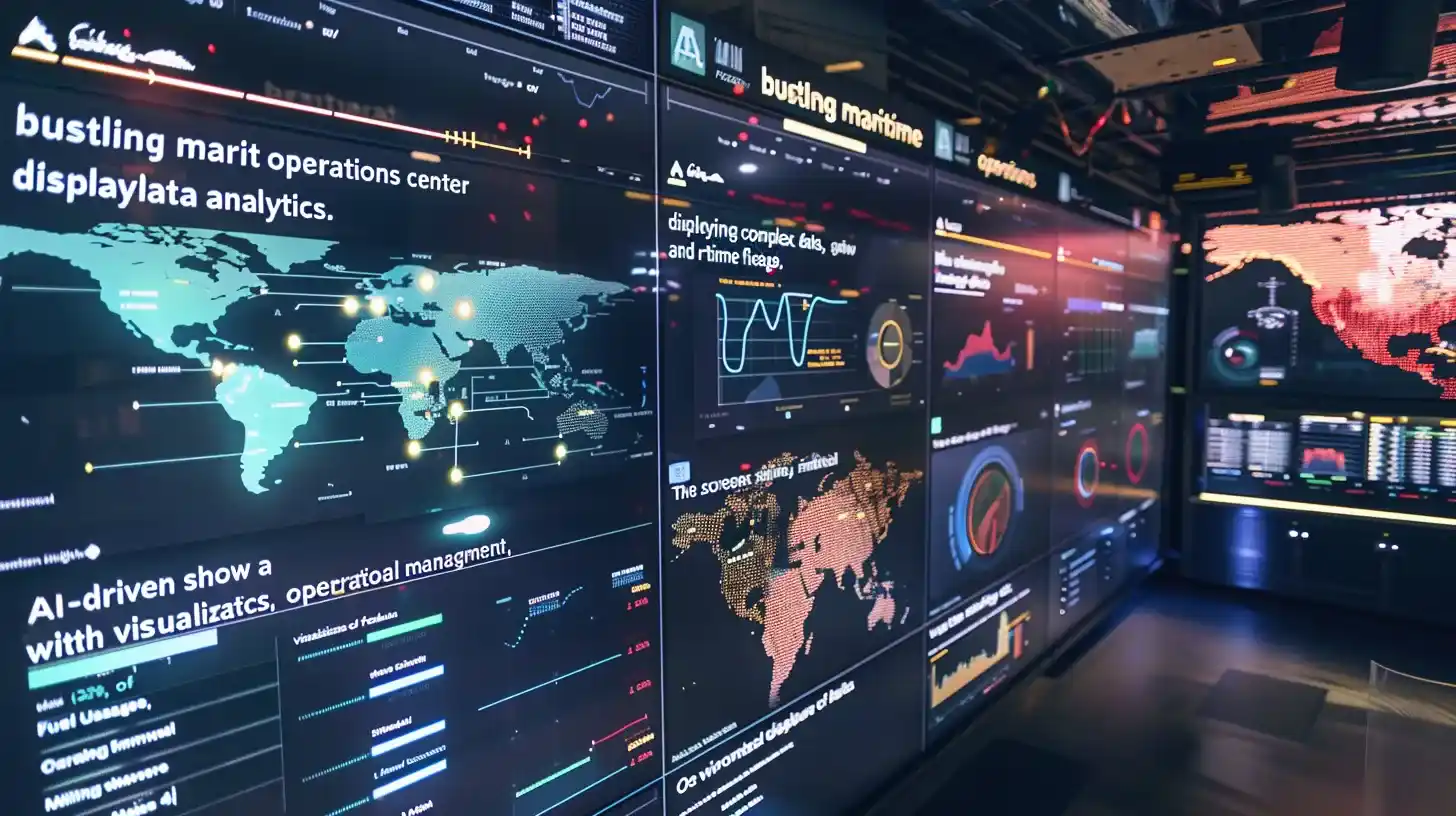Table of Contents
Maritime Transport: Artificial Intelligence can forecast the times when machinery and vessels will require upkeep, aiding in minimizing interruptions and cutting expenses. For example, AI can examine information from engine sensors on ships to identify trends that signal the necessity for maintenance, enabling preventive fixes and avoiding unforeseen failures.
How Artificial Intelligence is Steering the Future of Shipping
The shipping sector is currently grappling with difficult times. Companies worldwide are constantly making a wide array of operational and business choices, including adapting to changing customer needs, adhering to stringent new rules on carbon emissions, and dealing with geopolitical situations that have disrupted well-established trade paths.
The intricacy of planning for maritime transport operations cannot be overlooked. The amount of data on environmental and operational aspects for making decisions about the fleet has increased dramatically. The number of factors considered to improve the efficiency of each journey has grown significantly.

The risk of making mistakes has decreased. The sector is increasingly dealing with a shortage of workers across various operational areas. Moreover, the planning tools available today were not designed for an industry aiming to compete and prosper while aiming for net zero carbon emissions by 2050.
With its unmatched capacity to handle and analyze vast quantities of data, Artificial Intelligence is uniquely suited to tackle the complex issues this industry is facing. By leveraging AI, shipping companies can make sense of their operational, commercial, and environmental data to find patterns and improve the efficiency of voyage planning, speed, and fuel usage in ways that have never been seen before.
Furthermore, AI can offer suggestions to reduce emissions and ensure adherence to international standards, all while enhancing the efficiency of entire fleets with a level of speed and precision that traditional methods cannot match.
1. AI in Route Optimization for Ships
Core Concept: Leveraging AI algorithms to determine the most efficient and cost-effective routes for ships, considering factors like weather conditions, fuel consumption, traffic congestion, and port schedules.
How it Works:
- AI analyzes vast amounts of real-time data on ocean conditions, vessel performance, and market dynamics.
- It predicts optimal routes by considering variables like wind speed, wave height, fuel prices, and port congestion.
- Machine learning models continuously refine route suggestions based on historical data and new information.
Benefits:
- Significant reduction in fuel consumption and emissions.
- Improved vessel utilization and turnaround times.
- Enhanced operational efficiency and cost savings.
- Increased profitability for shipping companies.
2. Autonomous Vessels and AI Navigation
Core Concept: Develop ships capable of navigating and operating without human intervention, relying on AI for decision-making and control systems.
How it Works:
- Advanced sensors (radar, lidar, cameras) collect data about the vessel’s surroundings.
- AI algorithms process data to create a real-time 3D map of the environment.
- Decision-making systems based on AI determine the vessel’s course, speed, and maneuvers.
- AI-powered collision avoidance systems prevent accidents.
Benefits:
- Increased safety through reduced human error.
- Improved operational efficiency and reduced costs.
- Ability to operate in hazardous conditions.
- Potential for new maritime transport operations, such as deep-sea exploration.
3. AI for Marine Environmental Monitoring
Core Concept: Utilizing AI to collect, analyze, and interpret data about the maritime transport environment to support environmental protection and sustainable practices.
How it Works:
- AI-powered drones and autonomous underwater vehicles collect data on water quality, pollution levels, and marine life.
- AI algorithms analyze data to identify patterns, anomalies, and trends.
- Predictive models forecast environmental changes and potential risks.
- Real-time monitoring enables rapid response to environmental incidents.
Benefits:
- Improved understanding of marine ecosystems.
- Early detection and prevention of environmental disasters.
- Support for sustainable shipping practices and compliance with regulations.
- Contribution to marine conservation efforts.
4. AI-Powered Predictive Maintenance
Core Concept: Using AI to predict equipment failures and optimize maintenance schedules for ships, reducing downtime and increasing operational efficiency.
How it Works:
- Sensors collect data on equipment performance and operating conditions.
- AI algorithms analyze data to identify patterns indicating potential failures.
- Predictive models generate maintenance recommendations and spare parts requirements.
- Real-time monitoring enables proactive maintenance actions.
Benefits:
- Reduced equipment breakdowns and unplanned downtime.
- Optimized maintenance costs and resource allocation.
- Increased vessel availability and reliability.
- Improved safety by preventing equipment failures.
5. AI for Supply Chain Optimization
Core Concept: Applying AI to optimize the entire shipping supply chain, from cargo planning and routing to port operations and delivery.
How it Works:
- AI analyzes data on cargo volume, shipping routes, port capacities, and market demand.
- It optimizes cargo loading, vessel scheduling, and port operations for maximum efficiency.
- Predictive analytics forecasts demand and supply, enabling better inventory management.
- AI-powered logistics platforms facilitate seamless information sharing and collaboration.
Benefits:
- Reduced transportation costs and lead times.
- Improved supply chain visibility and responsiveness.
- Enhanced customer satisfaction through reliable delivery.
- Reduced environmental impact through optimized operations.
Top Use Cases of Big Data Analytics in the Maritime Transport Industry
Maximizing Route Efficiency Through Big Data Analytics
Shipping firms leverage extensive data sets to pinpoint the most efficient routes for their vessels. By examining both historical and current data on weather, ocean currents, and ship speeds, big data algorithms forecast the best path for a ship. This process goes beyond just finding the shortest route, taking into account fuel efficiency, time savings, and safety.

Proactive Maintenance to Minimize Downtime
The use of predictive analytics and artificial intelligence in the maritime transport sector employs cutting-edge methods to oversee and analyze data from various sources like ship equipment sensors, maintenance records, and environmental conditions. According to Nucleus Research, initiatives focused on predictive maintenance, including those in the maritime transport field, reduce downtime by 35% to 50%.
By compiling and analyzing data, predictive models can spot patterns and irregularities that hint at potential equipment failures. For example, abnormal vibrations, temperature changes, or spikes in energy use from a ship’s engine could signal an upcoming breakdown.
Strengthening Security and Ensuring Compliance with Data Analytics
Maritime transport companies can identify and address potential security risks by gathering and analyzing data from ship sensors, navigation systems, and communication networks. For example, systems that use big data analytics to detect unusual patterns in ship-to-shore communications can flag cyberattacks or system weaknesses.
The Automatic Identification System (AIS) boosts maritime transport security by providing detailed information on ship movements (name, direction, speed) and monitoring these movements at a high rate, with over 4,500 reports every 2 seconds.
Saving Time by Minimizing Email Overload
The adoption of big data analytics in the maritime transport industry significantly simplifies the management of email communications, especially in the face of the high volume of emails common in shipping operations. Big data tools utilize advanced algorithms to sort and categorize emails based on their urgency, relevance, and context.
This approach ensures that important information is readily available, thereby reducing the time employees spend navigating through their inboxes. For instance, by using the Sedna AI platform, Casper, a leading independent port agency, has managed to save 37.5 hours per week by automating document processing. Casper’s Group Operations Director Alan Appleyard explains how Sedna’s intelligent data extraction has not only saved Casper time but also money.
Conclusion
The maritime transport industry stands at the precipice of a transformative era, driven by rapid advancements in artificial intelligence. From optimizing ship routes and enabling autonomous navigation to safeguarding the marine environment and streamlining supply chains, AI is reshaping the industry’s landscape.
As AI technologies continue to mature, their integration into maritime transport operations will become increasingly sophisticated. The potential benefits are immense, including enhanced efficiency, cost reduction, improved safety, and greater sustainability.
However, it is crucial to address the challenges associated with AI implementation, such as data privacy, cybersecurity, and the need for skilled workforce development.
By embracing AI as a strategic tool, the maritime transport industry can unlock new opportunities, foster innovation, and solidify its position as a global leader in transportation and logistics. The future of maritime transport is undoubtedly intertwined with the advancement of artificial intelligence.